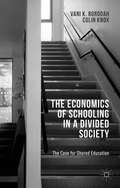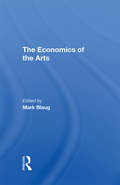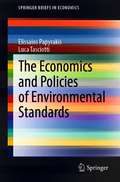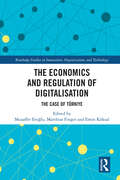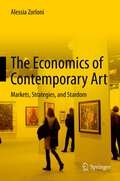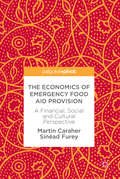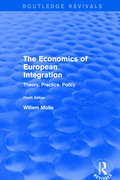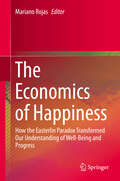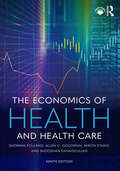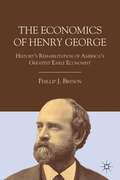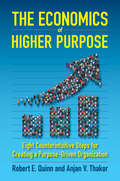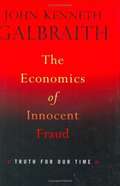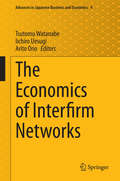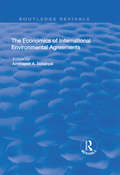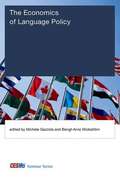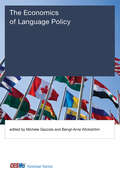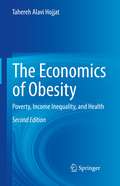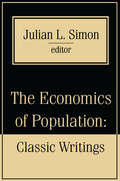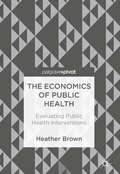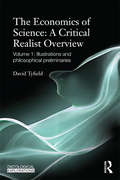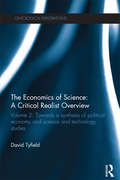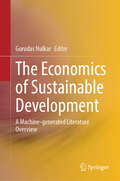- Table View
- List View
The Economics Of Schooling In A Divided Society
by Colin Knox Vani K. BorooahCountries that have suffered ethnic or religious conflict and become segregated societies reflect these divisions in education provision for their children. Northern Ireland is a case study in point where a parallel system of schools offers education in Catholic maintained schools and Protestant (de facto) controlled schools. While school segregation is the most obvious manifestation of Northern Ireland's fractured society, there are more important issues of 'educational inequality' with respect to schools and pupils. This book analyses three issues in some detail: segregation, educational performance and inequality in educational outcomes between schools and between pupils from deprived and affluent family backgrounds. Thus far public policies to tackle these issues have been met with limited success. The authors consider an alternative approach, which they term 'shared education', the aim of which is to improve school performance and, in so doing, to dismantle some of the barriers between maintained and controlled schools.
The Economics Of The Arts
by Mark BlaugThe economics of the Arts is a new field with a small but rapidly-growing literature, which has emerged in recent years out of the eagerness of economists to apply their techniques to hitherto untried areas and the recognition by Arts administrators of the rapidly increasing economic pressures on the Arts. This book of readings is the first of its kind. Of the 16 articles, 8 are directly concerned with the Arts in America; the other 8 deal with the British scene. What can economics say about so non-economic a subject as the Arts? Obviously, finance for the Arts involves economic considerations. But in addition, economics provides, among other things, a logic of rational choice, and the economists' style of thinking, therefore, is adaptable to any problem of choice in respect of any set of goals, whether they be economic goals or not. Then, there is the question of whether economics can provide a case for public support for the Arts, that is, whether the State should subsidize the Arts. This is a familiar problem in the economics of welfare but its application to the Arts raises novel questions and even economists are not agreed on whether economics can provide such a rationale. Also, there is the question of criteria for public expenditure on the Arts, assuming that the case for some public expenditure has been made. Can economists tell us how much the State should spend on the Arts? Surely, they can help us with a host of other questions: should museums and galleries charge fees; should museums ever sell off parts of their collections; can the Arts economize on their expenditures; how can modern music be most effectively encouraged by public funds; are ticket prices an important element in the demand for the Arts; and does the low pay of artists discourage individuals from taking up artistic occupations?
The Economics and Policies of Environmental Standards (SpringerBriefs in Economics)
by Elissaios Papyrakis Luca TasciottiThis book provides a critical perspective on several interconnected themes that relate to the implementation of both domestic and international environmental standards. What are the direct and indirect costs and benefits of these standards? What is the political economy structure that governs their implementation? Do environmental standards affect individuals and economic sectors in different ways? How do environmental standards interact with trade patterns in an ever-globalised world? Understanding the multidimensional effects of environmental standards is crucial for the establishment of effective environmental and development policies. The book presents our current state of knowledge for the issues presented, while also drawing policy insights from a WTO project (on phytosanitary standards) the authors undertook in four Sub-Sahara African countries (Botswana, Cameroon, Kenya and Mozambique).
The Economics and Regulation of Digitalisation: The Case of Türkiye (Routledge Studies in Innovation, Organizations and Technology)
by Matthias Finger Muzaffer Eroğlu Emin KöksalTurkey offers an interesting case study, both when it comes to the practice and the regulation of digitalization, as it combines a Western economic and legal system with an emerging country approach to digitalization. This co-edited volume examines the history, policies, economics, and various regulations of digitalization in Turkey.The chapters provide a comprehensive overview of how digitalization has developed in Turkey and how digitalization has come to be regulated, inspired by EU legislation yet with a “Turkish touch”. It explores the take up of digitalization by industry, society, and government, before delving into examples from FinTech and cryptocurrency, to social media and e-commerce, and yielding lessons for comparable emerging countries.Covering all the relevant aspects of digitalization, this book will be of interest to academics and students, particularly to those with an interest in innovation, economics of digitalization, policy, and regulation.
The Economics of Contemporary Art
by Alessia ZorloniThe book examines the contemporary art system with a broad and systematic approach, through the application of models of microeconomics and industrial organizations. By breaking down the traditional barriers between different academic disciplines such as art and economics, this book offers a unique opportunity to grasp the complexities of the contemporary art world and provides the tools to conduct a structural analysis of that market. The result is an in-depth analysis of the contemporary art market from an interdisciplinary perspective. While it is not a textbook in the strictest sense, the book offers a concise and effective overview of all actors in the art system, and provides supporting data and valuable information, both conceptual and practical. It is therefore a text that can be used by students wishing to better understand the complex dynamics that govern the contemporary art market, but also by cultural managers, collectors, potential art investors or simply art lovers who need a quick reference.
The Economics of Economists
by Alessandro Lanteri Jack VromenThis is the first of a two volume collection of the late Julian Simon s important and radical contributions to a wide variety of economic problems. Often considered as controversial and unorthodox, these essays challenge conventional approaches. The book begins with introductory chapters in which the author discusses his background and experiences as a controversial scholar. Divided into six parts, the first part considers some basic concepts on issues such as welfare, natural resources, causality and product differentiation. The second part contains essays on managerial economics as well as general microeconomics including monopoly, duopoly and oligopoly. Advertising is discussed in the third part and industrial organization in the fourth. Part five focuses on policies for exchange and auction considering, among other issues, airline overbooking, and the final section features articles on macroeconomics. This collection of controversial essays will be welcomed by academics and students interested in unorthodox approaches to various economic theories and concepts.
The Economics of Education (Routledge Library Editions: Education)
by John SheehanThis book is a survey of the principal aspects of the economics of education, such as the demand for education as consumption and as an investment, good education and economic growth, education and manpower needs, and the finance of education. In some cases in recent years, economic theory has been applied to educational problems in order to gain an insight into the workings of the educational system. The result has been a certain amount of confusion and distrust among teachers and educationists: confusion because some theoretical aspects are not easily understood and distrust of the economist’s intrusion into educational policy-making. This book overcomes these problems by making minimal demands on prior knowledge of economics and by emphasizing the limitations of economic analysis applied to policy matters.
The Economics of Emergency Food Aid Provision: A Financial, Social And Cultural Perspective
by Martin Caraher Sinéad FureyThis short book reviews the provision of food bank and other emergency food aid provision with a specific focus on the UK, whilst drawing lessons from North America, Brazil and Europe. The authors look at the historical positioning of food aid and the growth of the food aid sector in the UK following the period of austerity 2007-2012, before addressing the causes of food insecurity and concluding that food banks are a symptom of austerity and government inaction which fail to tackle the underlying causes of food poverty. The research is timely, and considers a range of disciplines and practices. This book will appeal to researchers, policy makers and practitioners food economics, welfare economics, public policy, public health, food studies, nutrition, and the wider social sciences.
The Economics of European Integration: Theory, Practice, Policy (Routledge Revivals Ser.)
by Willem MolleThis title was first published in 2001. As economic integration touches ever more areas of society, more and more people are confronted by the bewildering complexity of the functioning of the European Union. Rather than merely focusing on the description of EU policies, this study of the economics of European integration seeks to: select the most relevant aspects and developments; place the wide variety of issues in a robust conceptual structure; integrate theoretical developments with the results of empirical research and of policy analysis; explain the logic of the dynamic processes; describe the structural features of the European economy; highlight the response of private companies to changes in the regulatory environment; depict the historical developments so as to give a sound basis for the understanding of the present situation and the likely future development; and set the European developments in the light of global developments. In practice Western Europe is the focus of major parts of this book.
The Economics of Happiness: How the Easterlin Paradox Transformed Our Understanding of Well-Being and Progress
by Mariano RojasThis book presents a panoramic view of the implications from Richard Easterlin’s groundbreaking work on happiness and economics. Contributions in the book show the relevance of the Easterlin Paradox to main areas, such as the relationship between income and happiness, the relationship between economic growth and well-being, conceptions of progress and development, design and evaluation of policies for well-being, and the use of happiness research to address welfare economics issues. This book is unique in the sense that it gathers contributions from senior and top researchers in the economics of happiness, whom have played a central role in the consolidation of happiness economics, as well as promising young scholars, showing the current dynamism and consolidation of happiness economics.
The Economics of Health and Health Care: International Student Edition, 8th Edition
by Sherman Folland Allen C. Goodman Miron Stano Shooshan DanagoulianThe Economics of Health and Health Care is the market-leading health economics textbook, providing comprehensive coverage of all the key topics, and balancing economic theory, empirical evidence, and public policy. The ninth edition offers updated material throughout, including two new chapters: Disparities in Health and Health Care (Chapter 7) examines issues of race, ethnicity, income, gender, and geography with respect to health care access, health inputs, and health outcomes; Pandemic Economics (Chapter 9) introduces a new and simplified economic treatment of epidemics and pandemics within the context of COVID-19. We also include applications from the growing literature on digital medicine. The book further highlights the impacts of the Affordable Care Act (ACA) and updates its path-breaking comparative analyses across countries to focus on the differences in access and costs. The book continues to provide a clear, step-by-step understanding of health economics, making economic principles accessible to students, supported by boxed examples, figures and tables. Each chapter contains concise summaries, discussion questions, and quantitative exercises to promote student learning. There is also a glossary of key terms and an extensive reference list. Instructors are supported by a range of digital supplements. It is the perfect textbook for students and practitioners taking undergraduate and postgraduate courses in health economics, health policy, and public health.
The Economics of Henry George
by Phillip J. BrysonHenry George the greatest, most famous and most rejected of early American economists who trained himself in classical economics and developed a theory of a 'single tax'. There is much literature on many specific facets and aspects of George's work, but we lack a book which provides an overview of George's economics. . . until now!
The Economics of Higher Purpose: Eight Counterintuitive Steps for Creating a Purpose-Driven Organization
by Robert E. Quinn Anjan V. ThakorTwo distinguished scholars offer eight steps to help organizations discover and embrace an authentic higher purpose—something that will dramatically improve every aspect of any enterprise, including the bottom line.What does a lofty notion like purpose have to do with business basics like the bottom line? Robert E. Quinn and Anjan J. Thakor say pretty much everything. Leaders and managers are taught that employees are self-interested and work resistant, so they create systems of control to combat these expectations. Workers resent these systems, and performance suffers. To address the performance issues, managers double down on the coercion, creating a vicious cycle and a self-fulfilling prophecy. But there is a better way. Quinn and Thakor show that when an authentic higher purpose permeates business strategy and decision-making, the cycle is broken. Employers and employees see themselves as working together toward an inspiring goal, not just trying to hit quarterly targets. They fully engage, become proactive contributors, and, ironically, easily exceed those quarterly targets. Based on their widely acclaimed Harvard Business Review article, Quinn and Thakor offer eight sometimes surprising steps for shifting from a transaction-oriented mind-set focused on constraints to a purpose-oriented mind-set focused on possibility. This iconoclastic book will help any organization discover its authentic purpose and weave it into the fabric of everything it does, leading to unprecedented levels of personal satisfaction, service and product innovation, and economic growth.
The Economics of Innocent Fraud: Truth for Our Time
by John Kenneth GalbraithThe primary aspect of the "fraud" of the American economy that Galbraith (emeritus, economics, Harvard U.) criticizes is the false pretense of shareholder control over corporations, when in fact all real power has shifted to corporate managers. Contradicting conventional wisdom, or "approved belief" in his words, he denies the distinction between the private and public sectors, describing how the managerial class has unprecedented power in the economy's public sector, including major influence over important policies of war or peace. In the end, the continuing references to an impersonal market are "a not wholly innocent fraud."
The Economics of Interfirm Networks
by Arito Ono Iichiro Uesugi Tsutomu WatanabeThis book is one of the first comprehensive works to fill the knowledge gap resulting from the limited number of empirical studies on interfirm networks. The in-depth empirical research presented here is based on a massive transaction relationship database of approximately 400,000 Japanese firms. This volume, unlike others, focuses on the role of interfirm networks in three different fields: (1) macroeconomic activities, (2) economic geography and firm dynamics, and (3) firm-bank relationships. The database for this work is constructed in collaboration with Japan's largest credit research company, Teikoku Data Bank, and covers a substantial portion of Japanese firms with information on firms' transaction partners, shareholders, financial institutions, and other attributes, including their locations and performance. Networks prevail in many aspects of economic activities and play a major role in explaining a wide variety of economic phenomena from business cycles to knowledge spillovers, which has motivated economists to produce a number of excellent works. In the policy arena, there has been a growing concern on the vulnerabilities of networks based on the casual observation that idiosyncratic shocks on firms can be amplified through inter-firm connections and leads to a systemic crisis. Typical examples are the manufacturing supply-chain networks in the automobile and electronics industries which propagated regionally concentrated shocks (the Great East Japan Earthquake and floods in Thailand in 2011) into global ones. An abundance of theoretical literature on the formation and functions of networks is available already. This book breaks new ground, however, and provides an excellent opportunity for the reader to gain a more integrated understanding of the role of networks in the economy. The Economics of Interfirm Networks will be of special interest to economists and practitioners seeking empirical and quantitative knowledge on interfirm and firm-bank networks.
The Economics of International Environmental Agreements (Routledge Revivals)
by Amitrajeet A. BatabyalThis title was first published in 2000: Conflicts between developed and developing countries over global environmental problems, and the fact that the co-operation required to solve environmental collective action problems is typically elusive in the world of international relations, suggests a research agenda regarding how one might hop to bring about co-operation in an inherently non-co-operative international setting. In particular, what can economic theory tell us about the design of international environmental agreements (IEAs) that will protect the world's fragile environmental resources? This book collects work on IEAs which demonstrates the value of rigorous microeconomic and econometric modelling in comprehending the many and varied facets of the design and implementation in IEAs.
The Economics of Language Policy
by Bengt-Arne Wickström Michele GazzolaIn an era of globalization, issues of language diversity have economic and political implications. Transnational labor mobility, trade, social inclusion of migrants, democracy in multilingual countries, and companies' international competitiveness all have a linguistic dimension; yet economists in general do not include language as a variable in their research. This volume demonstrates that the application of rigorous economic theories and research methods to issues of language policy yields valuable insights. The contributors offer both theoretical and empirical analyses of such topics as the impact of language diversity on economic outcomes, the distributive effects of policy regarding official languages, the individual welfare consequences of bilingualism, and the link between language and national identity. Their research is based on data from countries including Canada, India, Kazakhstan, and Indonesia and from the regions of Central America, Europe, and Sub-Saharan Africa. Theoretical models are explained intuitively for the nonspecialist. The relationships among linguistic variables, inequality, and the economy are approached from different perspectives, including economics, sociolinguistics, and political science. For this reason, the book offers a substantive contribution to interdisciplinary work on languages in society and language policy, proposing a common framework for a shared research area.ContributorsAlisher Aldashev, Katalin Buzási, Ramon Caminal, Alexander M. Danzer, Maxime Leblanc Desgagné, Peter H. Egger, Ainhoa Aparicio Fenoll, Michele Gazzola, Victor Ginsburgh, Gilles Grenier, François Grin, Zoe Kuehn, Andrea Lassmann, Stephen May, Serge Nadeau, Suzanne Romaine, Selma K. Sonntag, Stefan Sperlich, José-Ramón Uriarte, François Vaillancourt, Shlomo Weber, Bengt-Arne Wickström, Lauren Zentz
The Economics of Language Policy (CESifo Seminar Series)
by Bengt-Arne Wickström Michele GazzolaInsights from the application of economic theories and research methods to the management of linguistic diversity in an era of globalization.In an era of globalization, issues of language diversity have economic and political implications. Transnational labor mobility, trade, social inclusion of migrants, democracy in multilingual countries, and companies' international competitiveness all have a linguistic dimension; yet economists in general do not include language as a variable in their research. This volume demonstrates that the application of rigorous economic theories and research methods to issues of language policy yields valuable insights. The contributors offer both theoretical and empirical analyses of such topics as the impact of language diversity on economic outcomes, the distributive effects of policy regarding official languages, the individual welfare consequences of bilingualism, and the link between language and national identity. Their research is based on data from countries including Canada, India, Kazakhstan, and Indonesia and from the regions of Central America, Europe, and Sub-Saharan Africa. Theoretical models are explained intuitively for the nonspecialist. The relationships among linguistic variables, inequality, and the economy are approached from different perspectives, including economics, sociolinguistics, and political science. For this reason, the book offers a substantive contribution to interdisciplinary work on languages in society and language policy, proposing a common framework for a shared research area.ContributorsAlisher Aldashev, Katalin Buzási, Ramon Caminal, Alexander M. Danzer, Maxime Leblanc Desgagné, Peter H. Egger, Ainhoa Aparicio Fenoll, Michele Gazzola, Victor Ginsburgh, Gilles Grenier, François Grin, Zoe Kuehn, Andrea Lassmann, Stephen May, Serge Nadeau, Suzanne Romaine, Selma K. Sonntag, Stefan Sperlich, José-Ramón Uriarte, François Vaillancourt, Shlomo Weber, Bengt-Arne Wickström, Lauren Zentz
The Economics of Obesity: Poverty, Income Inequality, and Health
by Tahereh Alavi HojjatMuch has been written about the economic causes of obesity, but this book offers a comprehensive and deep investigation of the causes and treatment of these issues in a single volume. In the second edition, the author expands upon the serious threat that obesity poses not only to our health, but also to our society. Obesity costs billions of dollars a year in lost productivity and medical expenses. The social distribution of obesity has changed over time. Obesity rates in the United States continue to worsen in parallel with income inequality. Socioeconomic groups with low personal capital, levels of education, and income have higher obesity rates. In fact, the rate of obesity has increased the fastest among low-income Americans. The disproportionate burden of obesity on the poor poses an economic challenge and an ethical imperative. The link between obesity, inactivity, and poverty may be too costly to ignore because obesity-associated chronic disease already accounts for 70% of US healthcare costs. Although economic and technological changes in the environment drove the obesity epidemic, the evidence for effective economic policies to prevent obesity remains limited.The new edition brings together a multitude of topics on obesity previously not discussed with a particular emphasis on the influence of poverty and income inequality on obesity including:Economic Analysis: Behavioral Patterns, Diet Choice, and the Role of Government Income and Wealth Inequality and Obesity Social Mobility and HealthFood Policies, Government Interventions, and Reducing Poverty The Economics of Obesity is an essential text for readers interested in learning about the causes and consequences of obesity within a social context including students, academicians, and practitioners in public health, medicine, social sciences, and health economics, both in and outside of the United States. US and international policy-makers also will find the book a salient read in addressing the issues that contribute to the cycle of poverty, income inequality, and obesity.
The Economics of Population: Key Classic Writings (The\international Library Of Critical Writings In Economics Ser. #No. 78)
by Julian SimonThe economics of population has a long and controversial history as well as an exciting present. Vociferous popular debate, public policy, and population economics have unduly influenced one another: public debate and policy affect the erection of economists' conclusions just as the results of economists' studies influence debate and popular thought. The words and theories of John Maynard Keynes, Thomas R. Malthus, John Stuart Mill, and Friedrich Engels come to mind immediately. However, many writings on population economics had little or no influence on public thought at the time they were written, although they may be seen as "correct" in light of modern developments. In fact, many of the ideas contained in these writings were publicly debated but then ignored for a long time, reappearing much later or reinvented independently.The Economics of Population, edited by Julian L. Simon, traces the history of population economics. This is a century-spanning collection of essays from foremost influential economic theorists, arranged to illustrate thought development and its numerous reversals. The first section includes essays from Joseph J. Spengler, John Graunt, William Petty, Thomas R. Malthus, William Godwin, and David Ricardo. Theorists such as Alexander Everett, William Peterson, Simon Gray, Henry C. Carey, John Stuart Mill, Friedrich Engels, Henry George, and Charles Fourier are the subject of the volume's second section. Finally, Simon covers the effect of population density and cities on productivity, and the effect of density on agricultural practices and natural resources. Essays from this section include John Maynard Keynes' "Is Britain Overpopulated?" and "The Economic Consequences of Peace" as well as selections from Lionel Robbins, George Simmel, and Alvin H. Hansen.Simon's long-term focus reflects the evolution of population movements. He does not restrict himself to writings that have been important in the historical chain of intellectual influence. Rather, he guides us to key works which shed light on the intellectual history of population economics. Simon includes some essays that, while greatly influential, can also be seen as fundamentally wrong in light of later work. As such, The Economics of Population will be of great value to political economists, sociologists of knowledge, and historians of ideas.
The Economics of Public Health: Evaluating Public Health Interventions
by Heather BrownNon-communicable diseases have surpassed infectious diseases as the leading cause of morbidity and mortality in developed countries. Prevention and treatment of the causes and consequences of lifestyle-related diseases forms an important part of health policy in the twenty-first century. Public health economics – from quantifying the problem, to evaluating interventions and developing toolkits to assist decision makers – is an essential area for any postgraduate student and researcher with an interest in applied economics to understand. There are a wide range of techniques from mainstream economics and health economics that can be applied to the evaluation of public health policy and public health issues. In this book, Brown presents examples from developed countries to illustrate how economic tools can be applied to public health. Further, cross-country comparisons illustrate how contextual factors related to healthcare systems, demographics and environmental factors may impact on outcomes and the cost-effectiveness of public health policies, in order to aid understanding and help students apply theory into practice.
The Economics of Religion in India
by Sriya IyerReligion is not a popular target for economic analysis. Yet the economist’s tools offer insights into how religious groups compete, deliver social services, and reach out to converts—how religions nurture and deploy market power. Sriya Iyer puts these tools to use in an expansive study of India, one of the world’s most religiously diverse nations.
The Economics of Science: Volume 1: Illustrations and Philosophical Preliminaries
by David TyfieldDramatic and controversial changes in the funding of science over the past two decades, towards its increasing commercialization, have stimulated a huge literature trying to set out an "economics of science". Whether broadly in favour or against these changes, the vast majority of these frameworks employ ahistorical analyses that cannot conceptualise, let alone address, the questions of "why have these changes occurred?" and "why now?" Nor, therefore, can they offer much insight into the crucial question of future trends. Given the growing importance of science and innovation in an age of both a globalizing knowledge-based economy (itself in crisis) and enormous challenges that demand scientific and technological responses, these are significant gaps in our understanding of important contemporary social processes. This book argues that the fundamental underlying problem in all cases is the ontological shallowness of these theories, which can only be remedied by attention to ontological presuppositions. Conversely, a critical realist approach affords the integration of a realist political economy into the analysis of the economics of science that does afford explicit attention to these crucial questions; a ‘cultural political economy of research and innovation’ (CPERI). Accordingly, the book sets out an introduction to the existing literature on the economics of science together with novel discussion of the field from a critical realist perspective. In arguing thus across levels of abstraction, however, the book also explores how concerted engagement with substantive social enquiry and theoretical debate develops and strengthens critical realism as a philosophical project, rather than simply ‘applying’ it. Divided into two volumes, in this first volume the book explores the ‘top’ and ‘tail’ of the argument, regarding substantive and philosophical aspects. Starting with substantive illustrations, we explore the social challenges associated with the contemporary commercialization of science and the movement towards a knowledge-based bio-economy. Having shown the explanatory benefits of assuming a realist political economy perspective, the book then turns to the task of reconstructing and justifying that theoretical perspective. True to the overall argument regarding attention to ontological presuppositions, this starts with critical realism’s critique of mainstream economics but also develops critical realism itself towards what may be called a ‘transcendental constructivism’.
The Economics of Science: Volume 2: Towards a Synthesis of Political Economy and Science and Technology Studies
by David TyfieldDramatic and controversial changes in the funding of science over the past two decades, towards its increasing commercialization, have stimulated a huge literature trying to set out an "economics of science". Whether broadly in favour or against these changes, the vast majority of these frameworks employ ahistorical analyses that cannot conceptualise, let alone address, the questions of "why have these changes occurred?" and "why now?" Nor, therefore, can they offer much insight into the crucial question of future trends. Given the growing importance of science and innovation in an age of both a globalizing knowledge-based economy (itself in crisis) and enormous challenges that demand scientific and technological responses, these are significant gaps in our understanding of important contemporary social processes. This book argues that the fundamental underlying problem in all cases is the ontological shallowness of these theories, which can only be remedied by attention to ontological presuppositions. Conversely, a critical realist approach affords the integration of a realist political economy into the analysis of the economics of science that does afford explicit attention to these crucial questions; a ‘cultural political economy of research and innovation’ (CPERI). Accordingly, the book sets out an introduction to the existing literature on the economics of science together with novel discussion of the field from a critical realist perspective. In arguing thus across levels of abstraction, however, the book also explores how concerted engagement with substantive social enquiry and theoretical debate develops and strengthens critical realism as a philosophical project, rather than simply ‘applying’ it. While the first of these two volumes argues how mainstream economics is inadequate to the task of an explanatory and critical ‘economics of science’, the challenge in this second volume is to examine the strengths and weaknesses of disciplines offering more promising starting points. Two social scientific disciplines are particularly promising candidates, starting from ‘economy’ or ‘science’, namely heterodox political economy and science & technology studies respectively. Synthesising these into an ‘economics of science’, however, still encounters considerable hurdles, in that there remain some fundamental and mutual philosophical incompatibilities. Formulating an ‘economics of science’ thus demands that both ‘economics’ and ‘science’ be redefined. The book explores how a critical realist approach affords some common ground upon which this productive synthesis may be pursued, in the form of a cultural political economy of research and innovation (CPERI).
The Economics of Sustainable Development: A Machine-generated Literature Overview
by Gurudas NulkarThis book is a machine-generated literature overview that explores the interlinkages between communities, both rural and urban, and how they are dependent on natural resources and ecosystem services for livelihoods. With increasing urbanization and changing land use, sourcing food, fuel, and other basic needs from forests and grasslands is turning into a significant challenge, especially in the developing world where they have to balance regional aspirations against the environmental impact and legacy for forthcoming generations. As sources of sustainable livelihoods decline, it affects their ability to overcome poverty. Furthermore, economic impacts on the natural capital can undermine the long-term sustainability of communities, and negatively affect their health and well-being.To ensure economic growth and sustainable livelihoods, it is imperative to rethink how economic growth and agriculture can reduce their impacts on the natural environment. How dowe integrate economic, social, and environmental aspects into our economy? The book will discuss aspects of sustainable consumption, conservation of ecosystems and biodiversity, and making rural communities resilient to the impacts of climate change. By recognizing the economic value of ecosystem services, decision-makers can better understand the benefits and costs of different land uses and resource management practices and make more informed choices that promote sustainable livelihoods and natural capital conservation. The book will be a great resource for policy-makers, students of economics and sustainable development, non-governmental organizations working in this field, and corporate managers who are responsible for allotting budgets towards corporate social responsibility programs.^
